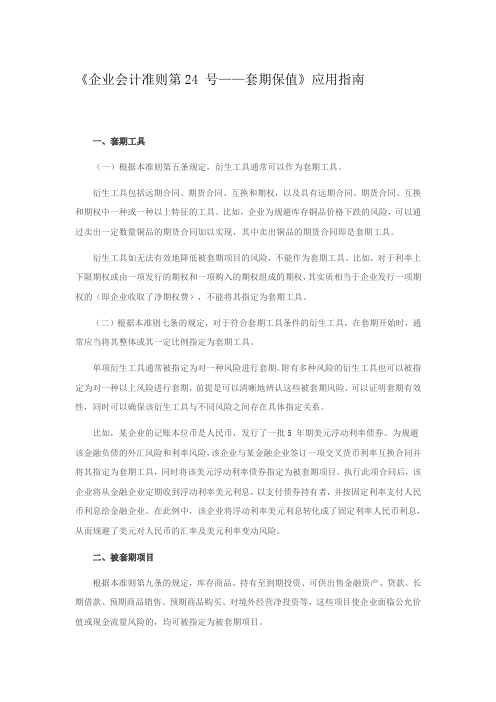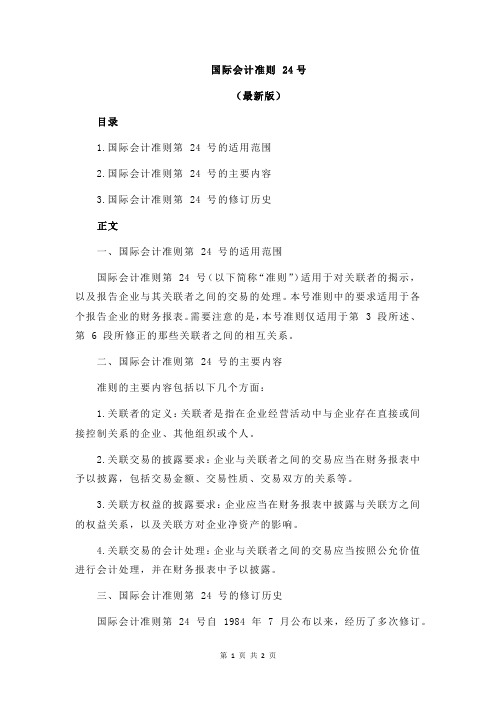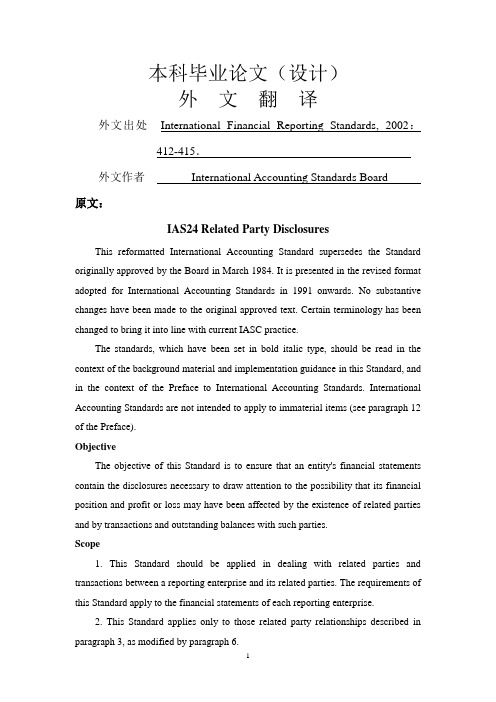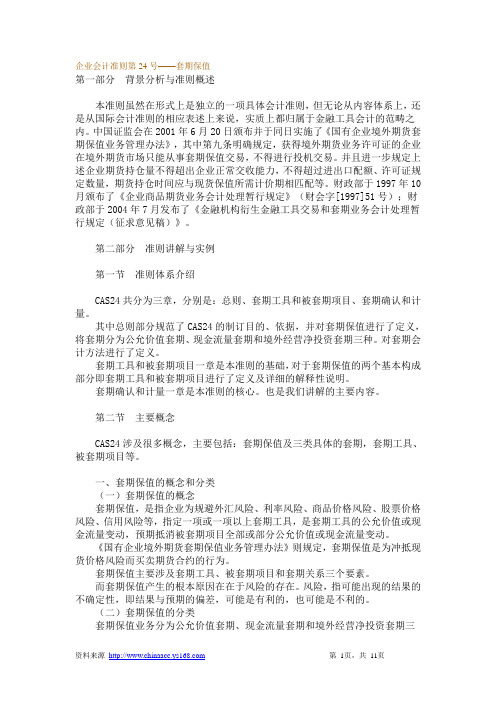国际会计准则第24号
财务管理之国际会计准则第24号.doc

定义
9.本准则使用的下列术语,其含义为:
关联方,满足以下条件者为实体的关联方: ( 1)直接或者通过一个或若干个中介间接地: ①控制、或是受实体的控制、或是与实体同受控制(包括母公司 、子 公司和伙伴子公司) ; ②在实体中有权益,因此对该实体有重大影响;或 ③对实体具有共同控制; ( 2 )联营企业(按《国际会计准则第 28 号——对联营企业投资会计》 的定义) ; ( 3 )实体是合营者的合营企业(参见《国际会计准则第 31 号——合营 中权益的财务报告》 ) ; ( 4) 实体或其母公司关键的管理人员, 即直接或间接地有权并负责计划、 指挥和控制实体活动的人员,包括该实体的所有董事(执行董事或非执行董 事)或高级职员; ( 5)与( 1)和( 4)项提及的个人关系密切的家庭成员; ( 6)由( 4)或( 5)项提及的个人拥有表决权,能直接或间接地控制或 共同控制,或者能对其施加重大影响的实体;或 ( 7)针对实体或其关联方实体的雇员福利的离职后福利计划。 关联方交易,指关联方之间相互转移资源、服务或义务,不论是否收取 价款。 控制,指为了从实体的活动中获取利益而决定该实体财务和经营政策的 权力。 共同控制,指按合同规定对某项经济活动共享控制。 重大影响,指参与实体财务和经营政策上的决定,但不控制这些政策的 权力。可以通过持股、章程或协议来获得重大影响。
管理人员报酬 A3.理事会建议不应披露管理人员报酬、业务费用津贴以及日常经营过程中支付 的同类项目,因为: (1)在某些地区,管理人员报酬的批准程序消除了进行关联方披露的根本 理由。 这些程序避免了关键管理人员和实体之间的关联方关系对日常经营过程中 支付的管理人员报酬金额的潜在影响; (2)要求披露管理人员报酬会导致隐私问题,在某些国家和地区,是通过 受托责任机制来解决这一问题,而非在财务报表中进行披露。 (3)如果要披露管理人员报酬,IAS24 则需要定义“管理人员”和“报酬” , 而这很可能是有争议的。而且, 只有在为所有形式的管理人员报酬制定了计量规 定后,才有可能对这些披露进行比较。
安永《国际财务报告准则更新》中文版本 (2015年12月31日)

10
号》的修订
国际会计准则第19号:设定受益计划:雇员缴存金--对《国际会计准则第19号》的修订
11
国际会计准则第27号:单独财务报表中的权益法--对《国际会计准则第27号》的修订
11
国际财务报告准则改进
12
第二部分:不纳入国际财务报告准则解释委员会2015年下半年度议程的事项
15
第三部分:国际会计准则理事会现行项目
第二部分总结了自2015年7月1日起在《国际财务报告准则解释 委员会最新资讯》1上发布的某些议程决定。如欲了解2015年7 月1日前发布的拒纳通知,请参阅之前版本的《国际财务报告准 则更新》。在某些拒纳通知中,解释委员会提及了可提供充足指 引的现有公告。这些拒纳通知提供了对公告应用的观点,且在 《国际会计准则第8号》第12段“其他会计文献和可接受的行业 惯例”规定的范围内。
第一部分的开始部分列示了一份截至不同年末的强制采用时间 表。在该表中,公告按照其生效日期列示。需要注意的是,很多 公告包含允许主体提前采用的条款。
该表之后是对公告的讨论,除年度改进项目集中在第一部分结尾 处之外,其余均按照相关准则在国际财务报告准则合订本(蓝皮 书)中的先后顺序排列。
当准则或解释业已发布但主体尚未采用时,《国际会计准则第8 号--会计政策、会计估计变更和差错》要求主体披露已知的 (或可合理估计的)与理解新公告对财务报表的可能影响相关的 信息,或者说明不披露的原因。第一部分开始部分的表格有助于 识别在此披露要求范围内的公告。
编制者的挑战在于了解未来所需面对的一切。
本刊的目的
本刊概述了准则和解释(公告)即将发生的变化,还提供了若干 现行项目的最新进展情况,而非提供有关这些主题的深度分析或 讨论。更确切地说,其目的在于强调这些变化的关键方面。在作 出决策或采取行动之前,请参考公告正文。
《企业会计准则第24 号——套期保值》应用指南

《企业会计准则第24 号——套期保值》应用指南一、套期工具(一)根据本准则第五条规定,衍生工具通常可以作为套期工具。
衍生工具包括远期合同、期货合同、互换和期权,以及具有远期合同、期货合同、互换和期权中一种或一种以上特征的工具。
比如,企业为规避库存铜品价格下跌的风险,可以通过卖出一定数量铜品的期货合同加以实现,其中卖出铜品的期货合同即是套期工具。
衍生工具如无法有效地降低被套期项目的风险,不能作为套期工具。
比如,对于利率上下限期权或由一项发行的期权和一项购入的期权组成的期权,其实质相当于企业发行一项期权的(即企业收取了净期权费),不能将其指定为套期工具。
(二)根据本准则七条的规定,对于符合套期工具条件的衍生工具,在套期开始时,通常应当将其整体或其一定比例指定为套期工具。
单项衍生工具通常被指定为对一种风险进行套期。
附有多种风险的衍生工具也可以被指定为对一种以上风险进行套期,前提是可以清晰地辨认这些被套期风险、可以证明套期有效性,同时可以确保该衍生工具与不同风险之间存在具体指定关系。
比如,某企业的记账本位币是人民币,发行了一批5 年期美元浮动利率债券。
为规避该金融负债的外汇风险和利率风险,该企业与某金融企业签订一项交叉货币利率互换合同并将其指定为套期工具,同时将该美元浮动利率债券指定为被套期项目。
执行此项合同后,该企业将从金融企业定期收到浮动利率美元利息,以支付债券持有者,并按固定利率支付人民币利息给金融企业。
在此例中,该企业将浮动利率美元利息转化成了固定利率人民币利息,从而规避了美元对人民币的汇率及美元利率变动风险。
二、被套期项目根据本准则第九条的规定,库存商品、持有至到期投资、可供出售金融资产、贷款、长期借款、预期商品销售、预期商品购买、对境外经营净投资等,这些项目使企业面临公允价值或现金流量风险的,均可被指定为被套期项目。
根据本准则第十六条规定,对具有类似风险特征的资产或负债组合(即被套期项目)进行套期时,该组合中的各单项资产或单项负债应当共同承担被套期风险,且该组合内各单项资产或单项负债由被套期风险引起的公允价值变动,应当预期与该组合由被套期风险引起的公允价值整体变动基本成比例。
国际会计准则 24号

国际会计准则 24号
(最新版)
目录
1.国际会计准则第 24 号的适用范围
2.国际会计准则第 24 号的主要内容
3.国际会计准则第 24 号的修订历史
正文
一、国际会计准则第 24 号的适用范围
国际会计准则第 24 号(以下简称“准则”)适用于对关联者的揭示,以及报告企业与其关联者之间的交易的处理。
本号准则中的要求适用于各个报告企业的财务报表。
需要注意的是,本号准则仅适用于第 3 段所述、第 6 段所修正的那些关联者之间的相互关系。
二、国际会计准则第 24 号的主要内容
准则的主要内容包括以下几个方面:
1.关联者的定义:关联者是指在企业经营活动中与企业存在直接或间接控制关系的企业、其他组织或个人。
2.关联交易的披露要求:企业与关联者之间的交易应当在财务报表中予以披露,包括交易金额、交易性质、交易双方的关系等。
3.关联方权益的披露要求:企业应当在财务报表中披露与关联方之间的权益关系,以及关联方对企业净资产的影响。
4.关联交易的会计处理:企业与关联者之间的交易应当按照公允价值进行会计处理,并在财务报表中予以披露。
三、国际会计准则第 24 号的修订历史
国际会计准则第 24 号自 1984 年 7 月公布以来,经历了多次修订。
其中,最近的一次修订于 200X 年进行,对关联方披露的要求进行了进一步明确和完善。
国际会计准则第24号关联方披露外文翻译

本科毕业论文(设计)外文翻译外文出处International Financial Reporting Standards, 2002:412-415.外文作者International Accounting Standards Board原文:IAS24 Related Party DisclosuresThis reformatted International Accounting Standard supersedes the Standard originally approved by the Board in March 1984. It is presented in the revised format adopted for International Accounting Standards in 1991 onwards. No substantive changes have been made to the original approved text. Certain terminology has been changed to bring it into line with current IASC practice.The standards, which have been set in bold italic type, should be read in the context of the background material and implementation guidance in this Standard, and in the context of the Preface to International Accounting Standards. International Accounting Standards are not intended to apply to immaterial items (see paragraph 12 of the Preface).ObjectiveThe objective of this Standard is to ensure that an entity's financial statements contain the disclosures necessary to draw attention to the possibility that its financial position and profit or loss may have been affected by the existence of related parties and by transactions and outstanding balances with such parties.Scope1. This Standard should be applied in dealing with related parties and transactions between a reporting enterprise and its related parties. The requirements of this Standard apply to the financial statements of each reporting enterprise.2. This Standard applies only to those related party relationships described in paragraph 3, as modified by paragraph 6.3. This Standard deals only with those related party relationships described in (a) to (e) below:(a) Enterprises that directly, or indirectly through one or more intermediaries, control, or are controlled by, or are under common control with, the reporting enterprise. (This includes holding companies, subsidiaries and fellow subsidiaries);(b) Associates (see IAS 28, Accounting for Investments in Associates);(c) Individuals owning, directly or indirectly, an interest in the voting power of the reporting enterprise that gives them significant influence over the enterprise, and close members of the family [1] of any such individual;(d) Key management personnel, that is, those persons having authority and responsibility for planning, directing and controlling the activities of the reporting enterprise, including directors and officers of companies and close members of the families of such individuals; and(e) Enterprises in which a substantial interest in the voting power is owned, directly or indirectly, by any person described in (c) or (d) or over which such a person is able to exercise significant influence. This includes enterprises owned by directors or major shareholders of the reporting enterprise and enterprises that have a member of key management in common with the reporting enterprise. In considering each possible related party relationship, attention is directed to the substance of the relationship, and not merely the legal form.4. No disclosure of transactions is required:(a) In consolidated financial statements in respect of intra-group transactions;(b) In parent financial statements when they are made available or published with the consolidated financial statements;(c) In financial statements of a wholly-owned subsidiary if its parent is incorporated in the same country and provides consolidated financial statements in that country; and(d) In financial statements of state-controlled enterprises of transactions with other state- controlled enterprises.Definitions5. The following terms are used in this Standard with the meanings specified:Related party - parties are considered to be related if one party has the ability to control the other party or exercise significant influence over the other party in making financial and operating decisions.Related party transaction - a transfer of resources or obligations between related parties, regardless of whether a price is charged.Control - ownership, directly, or indirectly through subsidiaries, of more than one half of the voting power of an enterprise, or a substantial interest in voting power and the power to direct, by statute or agreement, the financial and operating policies of the management of the enterprise.Significant influence (for the purpose of this Standard) - participation in the financial and operating policy decisions of an enterprise, but not control of those policies. Significant influence may be exercised in several ways, usually by representation on the board of directors but also by, for example, participation in the policy making process, material intercompany transactions, Inter change of managerial personnel or dependence on technical information. Significant Influence may be gained by share ownership, statute or agreement. With share ownership, significant influence is presumed in accordance with the definition contained in IAS 28, Accounting for Investments in Associates.6. In the context of this Standard, the following are deemed not to be related parties:(a) Two companies simply because they have a director in common, notwithstanding paragraphs 3 (d) and (e) above, (but it is necessary to consider the possibility, and to assess the likelihood, that the director would be able to affect the policies of both companies in their mutual dealings);(b) (i) Providers of finance;(ii) Trade unions;(iii) Public utilities;(iv) Government departments and agencies,In the course of their normal dealings with an enterprise by virtue only of thosedealings (although they may circumscribe the freedom of action of an enterprise or participate in its decision-making process); and(c) A single customer, supplier, franchisor, distributor, or general agent with whom an enterprise transacts a significant volume of business merely by virtue of the resulting economic dependence.The Related Party Issue7. Related party relationships are a normal feature of commerce and business. For example, enterprises frequently carry on separate parts of their activities through subsidiary or associated enterprises and acquire interests in other enterprises - for investment purposes or for trading reasons - that are of sufficient proportions that the investing company can control or exercise significant influence on the financial and operating decisions of its investee.8. A related party relationship could have an effect on the financial position and operating results of the reporting enterprise. Related parties may enter into transactions which unrelated parties would not enter into. Also, transactions between related parties may not be effected at the same amounts as between unrelated parties.9. The operating results and financial position of an enterprise may be affected by a related party relationship even if related party transactions do not occur. The mere existence of the relationship may be sufficient to affect the transactions of the reporting enterprise with other parties. For example, a subsidiary may terminate relations with a trading partner on acquisition by the parent of a fellow subsidiary engaged in the same trade as the former partner. Alternatively, one party may refrain from acting because of the significant influence of another - for example, a subsidiary may be instructed by its parent not to engage in research and development.10. Because there is an inherent difficulty for management to determine the effect of influences which do not lead to transactions, disclosure of such effects is not required by this Standard.11. Accounting recognition of a transfer of resources is normally based on the price agreed between the parties. Between unrelated parties the price is an arm's length price. Related parties may have a degree of flexibility in the price-settingprocess that is not present in transactions between unrelated parties.12. A variety of methods is used to price transactions between related parties.13. One way of determining a price for a transaction between related parties is by the comparable uncontrolled price method, which sets the price by reference to comparable goods sold in an economically comparable market to a buyer unrelated to the seller. Where the goods or services supplied in a related party transaction, and the conditions relating thereto, are similar to those in normal trading transactions, this method is often used. It is also often used for determining the cost of finance.14. Where goods are transferred between related parties before sale to an independent party, the resale price method is often used. This reduces the resale price by a margin, representing an amount from which the re-seller would seek to cover his costs and make an appropriate profit, to arrive at a transfer price to the re-seller. There are problems of judgment in determining compensation appropriate to the re-seller's contribution to the process. This method is also used for transfers of other resources, such as rights and services.15. Another approach is the cost-plus method, which seeks to add an appropriate mark-up to the supplier's cost. Difficulties may be experienced in determining both the elements of cost attributable and the mark-up. Among the yardsticks that may assist in determining transfer prices are comparable returns in similar industries on turnover or capital employed.16. Sometimes prices of related party transactions are not determined under one of the methods described in paragraphs 13 to 15 above. Sometimes, no price is charged - as in the examples of the free provision of management services and the extension of free credit on a debt.17. Sometimes, transactions would not have taken place if the relationship had not existed. For example, a company that sold a large proportion of its production to its parent company at cost might not have found an alternative customer if the parent company had not purchased the goods.Disclosure18. In many countries the laws require financial statements to give disclosuresabout certain categories of related parties. In particular, attention is focused on transactions with the directors of an enterprise, especially their remuneration and borrowings, because of the fiduciary nature of their relationship with the enterprise, as well as disclosures of significant intercompany transactions and investments in and balances with group and associated companies and with directors. IAS 27, Consolidated Financial Statements and Accounting for Investments in Subsidiaries, and IAS 28, Accounting for Investments in Associates require disclosure of a list of significant subsidiaries and associates. IAS 8, Net Profit or Loss for the Period, Fundamental Errors and Changes in Accounting Policies, requires disclosure of extraordinary items and items of income and expense within profit or loss from ordinary activities that are of such size, nature or incidence that their disclosure is relevant to explain the performance of the enterprise for the period.19. The following are examples of situations where related party transactions may lead to disclosures by a reporting enterprise in the period which they affect:(a) Purchases or sales of goods (finished or unfinished);(b) Purchases or sales of property and other assets;(c) Rendering or receiving of services;(d) Agency arrangements;(e) Leasing arrangements;(f) Transfer of research and development;(g) License agreements;(h) Finance (including loans and equity contributions in cash or in kind);(i) Guarantees and collaterals; and(j) Management contracts.20. Related party relationships where control exists should be disclosed irrespective of whether there have been transactions between the related parties.21. In order for a reader of financial statements to form a view about the effects of related party relationships on a reporting enterprise, it is appropriate to disclose the related party relationship where control exists, irrespective of whether there have been transactions between the related parties.22. If there have been transactions between related parties, the reporting enterprise should disclose the nature of the related party relationships as well as the types of transactions and the elements of the transactions necessary for an understanding of the financial statements.23. The elements of transactions necessary for an understanding of the financial statements would normally include:(a) An indication of the volume of the transactions, either as an amount or as an appropriate proportion;(b) Amounts or appropriate proportions of outstanding items; and(c) Pricing policies.24. Items of a similar nature may be disclosed in aggregate except when separate disclosure is necessary for an understanding of the effects of related party transactions on the financial statements of the reporting enterprise.25. Disclosure of transactions between members of a group is unnecessary in consolidated financial statements because consolidated financial statements present information about the parent and subsidiaries as a single reporting enterprise. Transactions with associated enterprises accounted for under the equity method are not eliminated and therefore require separate disclosure as related party transactions. Effective Date26. This International Accounting Standard becomes operative for financial statements covering the periods beginning on or after 1 January 1986.[1] Close members of the family of an individual are those that may be expected to influence, or be influenced by, that person in their dealings with the enterprise.International Accounting Standards Board, International Financial Reporting Standards, 2002:412-415.译文:国际会计准则第24号——关联方披露本国际会计准则重编版取代了理事会于1884批准的原准则,并按国际会计准则自1991年以来采用的修订格式重新编排。
2. 国际会计准则中文版

国际会计准则2003年9月19日国际会计准则(IAS)目录Framework for the Preparation and Presentation of Financial Statements (3)Preface (24)Procedure and Objective of IASB (27)IAS 1: Presentation of Financial Statements (33)IAS 2: Inventories (55)IAS 7: Cash Flow Statements (62)IAS 8: Net Profit or Loss for the Period, Fundamental Errors and Changes in Accounting Policies (73)IAS 10: Events After the Balance Sheet Date (82)IAS 11: Construction Contracts (93)IAS 12: Income Taxes (101)IAS 14: Segment Reporting (134)IAS 15: Information Reflecting the Effects of Changing Prices (150)IAS 16: Property, Plant and Equipment (155)IAS 17: Leases (169)IAS 18: Revenue (180)IAS 19: Employee Benefits (188)IAS 20: Accounting for Government Grants and Disclosure of Government Assistance (227)IAS 21: The Effects of Changes in Foreign Exchange Rates (233)IAS 22: Business Combinations (244)IAS 23: Borrowing Costs (270)IAS 24: Related Party Disclosures (275)IAS 26: Accounting and Reporting by Retirement Benefit Plans (280)IAS 27: Consolidated Financial Statements (288)IAS 28: Investments in Associates (294)IAS 29: Financial Reporting in Hyperinflationary Economies (301)IAS 30: Disclosures in the Financial Statements of Banks and Similar Financial Institutions (308)IAS 31: Financial Reporting of Interests in Joint Ventures (319)IAS 32: Financial Instruments: Disclosure and Presentation (328)IAS 33: Earnings per Share (351)IAS 34: Interim Financial Reporting (365)IAS 35: Discontinuing Operations (376)IAS 36: Impairment of Assets (385)IAS 37: Provisions, Contingent Liabilities and Contingent Assets (410)IAS 38: Intangible Assets (426)IAS 39: Financial Instruments: Recognition and Measurement (452)IAS 40: Investment Property (504)IAS 41: Agriculture (520)Framework for the Preparation and Presentation of Financial Statements编制和呈报财务报表的基本框架The IASB Framework is a conceptual accounting framework that sets out the concepts that underlie the preparation and presentation of financial statements for external users. It was approved in 1989. The IASB Framework assists the IASB:l in the development of future International Accounting Standards and in its review of existing International Accounting Standards; andl in promoting the harmonisation of regulations, accounting standards and procedures relating to the presentation of financial statements by providing a basis for reducing the number of alternative accounting treatments permitted by International Accounting Standards.In addition, the Framework may assist:l preparers of financial statements in applying International Accounting Standards and in dealing with topics that have yet to form the subject of an International Accounting Standard;l auditors in forming an opinion as to whether financial statements conform with International Accounting Standards;l users of financial statements in interpreting the information contained in financial statements prepared in conformity with International Accounting Standards; andl those who are interested in the work of IASB, providing them with information about its approach to the formulation of accounting standards.The Framework is not an International Accounting Standard and does not define standards for any particular measurement or disclosure issue.In a limited number of cases there may be a conflict between the Framework and a requirement within an International Accounting Standard. In those cases where there is a conflict, the requirements of the International Accounting Standard prevail over those of the Framework.世界上许多企业都编制并且向外部使用者呈报财务报表。
24企业会计准则第24号

企业会计准则第24号——套期保值第一部分背景分析与准则概述本准则虽然在形式上是独立的一项具体会计准则,但无论从内容体系上,还是从国际会计准则的相应表述上来说,实质上都归属于金融工具会计的范畴之内。
中国证监会在2001年6月20日颁布并于同日实施了《国有企业境外期货套期保值业务管理办法》,其中第九条明确规定,获得境外期货业务许可证的企业在境外期货市场只能从事套期保值交易,不得进行投机交易。
并且进一步规定上述企业期货持仓量不得超出企业正常交收能力,不得超过进出口配额、许可证规定数量,期货持仓时间应与现货保值所需计价期相匹配等。
财政部于1997年10月颁布了《企业商品期货业务会计处理暂行规定》(财会字[1997]51号);财政部于2004年7月发布了《金融机构衍生金融工具交易和套期业务会计处理暂行规定(征求意见稿)》。
第二部分准则讲解与实例第一节准则体系介绍CAS24共分为三章,分别是:总则、套期工具和被套期项目、套期确认和计量。
其中总则部分规范了CAS24的制订目的、依据,并对套期保值进行了定义,将套期分为公允价值套期、现金流量套期和境外经营净投资套期三种。
对套期会计方法进行了定义。
套期工具和被套期项目一章是本准则的基础,对于套期保值的两个基本构成部分即套期工具和被套期项目进行了定义及详细的解释性说明。
套期确认和计量一章是本准则的核心。
也是我们讲解的主要内容。
第二节主要概念CAS24涉及很多概念,主要包括:套期保值及三类具体的套期,套期工具、被套期项目等。
一、套期保值的概念和分类(一)套期保值的概念套期保值,是指企业为规避外汇风险、利率风险、商品价格风险、股票价格风险、信用风险等,指定一项或一项以上套期工具,是套期工具的公允价值或现金流量变动,预期抵消被套期项目全部或部分公允价值或现金流量变动。
《国有企业境外期货套期保值业务管理办法》则规定,套期保值是为冲抵现货价格风险而买卖期货合约的行为。
套期保值主要涉及套期工具、被套期项目和套期关系三个要素。
国际会计准则(中文版)【完整版】

国际会计准则(中文版)【完整版】(文档可以直接使用,也可根据实际需要修订后使用,可编辑放心下载)国际会计准那么〔中文版〕国际会计准那么〔中文版〕International Accounting Standards Chinese Edition目录7>1国际会计准那么第1号--会计政策的揭示4国际会计准那么第2号--存货10国际会计准那么第3号--已失效10国际会计准那么第4号--折旧会计13国际会计准那么第5号--已失效13国际会计准那么第6号--已失效13国际会计准那么第7号--现金流量表21国际会计准那么第8号--本期净损益、根本错误和会计政策的变更29国际会计准那么第9号--研究和开发费用35国际会计准那么第10号--或有事项和资产负债表日以后发生的事项39国际会计准那么第11号--建筑合同46国际会计准那么第12号--所得税会计53国际会计准那么第13号--已失效54国际会计准那么第14号--按分部报告财务信息58国际会计准那么第15号--反映价格变动影响的信息61国际会计准那么第16号--不动产、厂房和设备73国际会计准那么第17号--租赁会计82国际会计准那么第18号--收入89国际会计准那么第19号--退休金费用97国际会计准那么第20号--政府补助会计和对政府援助的揭示103国际会计准那么第21号--外汇汇率变动的影响111国际会计准那么第22号--企业合并124国际会计准那么第23号--借款费用128国际会计准那么第24号--对关联者的揭示132国际会计准那么第25号--投资会计140国际会计准那么第26号--退休金方案的会计和报告147国际会计准那么第27号--合并财务报表和对附属公司投资的会计152国际会计准那么第28号--对联营企业投资的会计156国际会计准那么第29号--在恶性通货膨胀经济中的财务报告161国际会计准那么第30号--银行和类似金融机构财务报表应揭示的信息171国际会计准那么第31号--合营中权益的财务报告178国际会计准那么第32号--金融工具:揭示和呈报197国际会计准那么第33号--每股收益208国际会计准那么第34号--中期财务报告216国际会计准那么第35号--中止经营223国际会计准那么第36号--资产减值242国际会计准那么第37号--准备、或有负债和或有资产255国际会计准那么第38号--无形资产275国际会计准那么第39号--金融工具:确认和计量313国际会计准那么第40号--投资性房地产325国际会计准那么第41号--农业国际会计准那么第1号--会计政策的揭示〔1975年1月公布,1994年11月格式重排〕范围13>.在揭示编制和呈报财务报表所采用的所有重要会计政策时,应该应用本号准那么。
- 1、下载文档前请自行甄别文档内容的完整性,平台不提供额外的编辑、内容补充、找答案等附加服务。
- 2、"仅部分预览"的文档,不可在线预览部分如存在完整性等问题,可反馈申请退款(可完整预览的文档不适用该条件!)。
- 3、如文档侵犯您的权益,请联系客服反馈,我们会尽快为您处理(人工客服工作时间:9:00-18:30)。
国际会计准则第24号--对关联者的揭示
国际会计准则第24号(1984年7月公布,1994年11月格式重排)范围
1.本号准则适用于对美联者以及报告企业与其关联者之间的交易的处理。
本号准则中的要求适用于各个报告企业的财务报表。
2.本号准则仅适用于第3段所述、第6段所修正的那些关联者之间的相互关系。
3.本号准则仅涉及下列第(l)-(5)段所述的那些关联者之间的相互关系:
(1)直接地或通过一个或若干个中间者间接地控制报告企业,或是被报告企业所控制以及和报告企业共同受控制的那些企业(其中包括控股公司、附属公司和其他附属公司);
(2)联营企业(见国际会计准则第28号对联营企业投资的会计);
(3)直接或间接地拥有报告企业有表决权的股份,并对该企业具有重大影响的那些个人及其关系密切的家庭成员;
(4)重要的管理人员,即有权力和责任来进行计划、指挥和控制报告企业活动的那些人员,包括公司的董事和高级职员以及与这些人关系密切的家庭成员;
(5)由上述第(3)段或第(4)段所述人员直接或间接地拥有重大表决权的企业,或是这种人员能够对其施加重大影响的企业。
它包括由报告企业的董事或主要股东拥有的企业,以及与报告企业拥有共同的重要管理人员的那些企业。
在考虑各种可能的关联者之间的相互关系时,应注意相互关系的实质,而不仅仅是法律形式。
4.不需要对交易作出揭示的情况有:
(1)在合并财务报表中,对有关集团内部之间的交易不需要作出揭示;
(2)当母公司财务报表与合并财务报表一起提供或公布时,在母公司的财务报表中不需要对交易作出揭示
(3)如果母公司与全资附属公司在同一国家经营并在该国提供合并财务报表,在全资附属公司的财务报表中不需要对交易作出揭示;
(4)在国家控制的企业的财务报表中,对与其他国家控制的企业的交易不需要作出揭示。
定义
5.本号准则所使用的下列术语,具有特定的含义:
关联者,是指在制订财务或经营决策中,如果一方有能力控制另一方,或对另一方施加重大影响,则认为它们是有关联的。
关联者之间的交易,是指在关联者之间相互转移资源或义务,不论是否收取价新。
控制,是指直接地或通过附属公司间接地拥有一个企业半数以上,或相当大姑量的表决权,并且根据章程或协议,有权指挥该企业的财务与经营政策。
重大影响(为本号准则的目的),是指参加企业财务和经营政策的制订,但不控制这些政策。
施加重大影响可以通过若干途径,通常可以通过出席董事会的方式,但也可以通过诸如参加政策的制定过程、重要的公司间交易、管理人员的交换、技术资料上的依赖性等方式。
重大影响可以通过股份的拥有、章程或协议达到。
对于拥有股份的情况,重大影响应按照国际会计准则第28号对联营企业投资的会计中的定义来假定。
6.在本号准则中,下列情况不视为是关联者:
(1)尽管有上述第3(4)段和第3(5)段的规定,但是因为两个公司具有一位共同的董事,这两个公司不认为是关联者(但是有必要考虑这位董事在两个公司的相互交易中,能够影响双方政策的可能性,并评估这种可能性);
(2)①资金提供者;
②工会;
③公用事业;
④政府部门和机构。
不应当仅以日常往来为由而视其为关联者(虽然它们可能限制一个企业的行动自由,或是参与其决策过程)。
(3)与企业发生大量业务的单个买主、供应商、专销商、批发商或一般代理商(不应仅仅由于因此产生的经济依赖性而视其为关联者)。
关于关联者的问题
7.与关联者之间的相互关系,是商业活动的通常特征。
例如,企业经常通过附属公司或联营企业从事一部分单独的经营活动,并且为了投资或贸易的目的购买其他企业的股权,而且此股权份额之大,足以使投资公司对被投资者的财务和经营决策施加重大的影响。
8.与关联者之间的相互关系可能会对报告企业的财务状况和经营成果发生影响。
关联者之间的交易活动,在无关联者之间可能不会发生。
并且,关联者之间的交易可能不会按与无关联者之间的交易相同的金额进行。
9.即使与关联者之间的交易不发生,企业的经营成果和财务状况也可能会受到关联者之间相互关系的影响。
仅是这种相互关系的存在,就可能足以影响报告企业与其他各方的交易。
例如,一家附属公司在其母公司购买了另一家与其以前的贸易伙伴经营相同业务的附属公司以后,就可能中断与该贸易伙伴的关系。
此外,某一方可能因另一方的重大影响而不采取行动。
例如,一家附属公司可能受其母公司的指示不进行研究和开发活动。
10.对于管理部门而言,确定不导致交易的影响效果,有内在的困难。
本号准则不要求揭示这种效果。
11.在会计上确认资源的转移通常依据各方同意的价格。
在无关联者之间的价格是一项公平价格。
而关联者之间在定价过程中可能具有一定程度的灵活性,这一点在无关联者之间是不会出现的。
12.关联者之间的交易可采用多种方法进行定价。
13.关联者之间的交易有一种定价方法是根据不受控制的可比价格,即参照在一个经济上可比较的市场上向与卖方无关联的一302一买方出售可比产品的情况来制订价格。
当在一项关联者之间的交易中提供产品或劳务,并且其有关条件与正常商业交易的条件相似时,就经常使用这种方法。
这一方法还常常用于确定财务费用。
14.如果货物在销售给独立的一方之前,在各关联者之间发生转移,通常使用再售价格法。
即从再售价格中扣减一笔毛利,其扣减额应能弥补再售者成本并赚取适当的利润,以便得出再售者应付的转移价格。
在确定与再售者的贡献相适应的报酬时,有一些需要运用判断的问题。
这一方法也可用于其他资源的转移,诸如权利与劳务等。
15.已另一种方法是成本加成法,即要求在供应商的成本上增加适当的附加额。
在确定可归属的成本要素和附加额时都可能发生一些困难。
类似行业的可比销售利润率或资金利润率,是有助于确定转移价格的几种尺度。
16.关联者之间的交易的价格,有的不是根据上述第13-15段所述的方法确定的。
有时甚至不计价格,例如,免费提供管理服务和延长免息债务信用期限等。
17.有时,若不存在相互关系,则交易就不会发生。
例如,一个将其大部分产品以成本价销售给母公司的公司,如果母公司不购买这些产品,可能就找不到另外的买主。
揭示
18.在很多国家,法律要求财务报表对某些类别的关联者给予揭示。
尤其是将注意力集中于与企业董事的交易,特别是他们的报酬与借款,因为他们与企业的关系具有信托性质。
此外,国际会计准则第5号财务报表应揭示的信息,要求揭示公司之间重大的交易,对集团内公司和联营公司的投资,以及与集团内公司、联营公司和董事们往来的余额。
国际会计准则第27号合并财务报表和对附属公司投资的会计与国际会计准则第28号对联营企业投资的会计,要求揭示重要的附属公司和联营企业的名单。
国际会计准则第8号本期净损益、基本错误和会计政策的变更,要求揭示非常项目以及由企业正常经营活动产生的收益与费用项目
(它们需达到这样的规模、性质和影响,以致对它们的揭示对说明企业在这一期间的经营业绩是至关重要的)。
19.在下列情况下,关联者之间的交易可能导致报告企业在它们影响的当期作出揭示:
(1)货物(产成品或半成品)的购买和销售;
(2)不动产或其他资产的购买和销售;
(3)劳务的提供或取得;
(4)代理安排;
(5)租赁安排;
(6)研究和开发的转让;
(7)许可证安排;
(8)理财(包括现金或实物的贷款或权益分配);
(9)担保和抵押;
(10)管理合同。
20.在存在控制的情况下,不论在关联者之间是否发生了交易,关联者之间的相互关系均应予以揭示。
21.为便于财务报表的读者了解关联者之间的关系对报告企上的影响,在存在控制的情况下,不论关联者之间是否发生了交易,揭示关联者之间的相互关系都是恰当的。
22.如果在关联者之间发生了交易,则报告企业应揭示关联者之间的相互关系的性质,以及为了了解财务报表所必须了解的交易类型与交易要素。
23.为了了解财务报表所必须了解的交易要素一般包括:
(1)对交易数量的说明,不论是以金额还是以适当的比例加以说明;
(2)未结算项目的金额或适当的比例;
(3)定价政策。
24.性质类似的项目可以用汇总的方式予以揭示,除非为了了解关联者之间的空易对报告企业财务报表的影响而需要分别予以揭示。
25.集团成员之间的交易不需在合并财务报表中揭示。
因为合并财务报表对母公司和附属公司已作为同一报告企业来提供资料。
在按权益法核算的情况下,与联营企业的交易不应略去,而应作为与关联者之间的交易来单独揭示。
生效日期
26.本号国际会计准则,对从1986年1月1日或以后开始的会计或间的财务报表生效。
